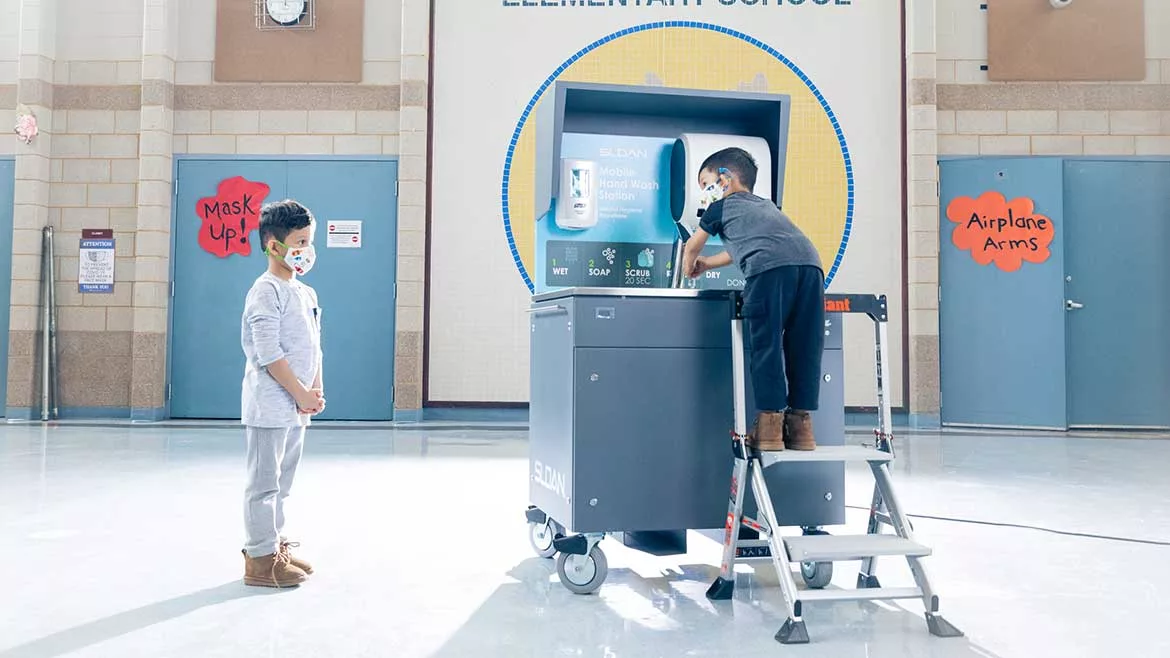Upgrading old school restrooms
Elementary and secondary schools have opportunity to utilize funding in support of restroom upgrades.

Bernhard Moos Elementary, a dual-language and International Baccalaureate school with students in Pre-K through eighth grade, needed to make sure its building was optimized to create a safe and hygiene-friendly learning environment as it welcomed students back to campus after months of remote learning due to the COVID-19 pandemic. The school implemented mobile handwashing stations in the cafeteria—a high-traffic area adjacent to the school’s outdoor lawn and playground—to provide convenient handwashing options. All images courtesy of Sloan
As part of the American Rescue Plan, educational funding can provide over $274 billion in support for schools — the largest investment ever in the history of primary and secondary education.
School restrooms are an ideal application for this funding, as one of its intended uses is to repair and improve school facilities to reduce the risk of virus transmission and exposure to environmental health hazards.
Yet, according to the Wall Street Journal, 73% of the allocated funds were still left unspent as of March 2023. With the commit-by date of September 30, 2024, time is running out for schools to take advantage of these funds.
With $189.5 billion budgeted for the Elementary and Secondary School Emergency Relief Fund (ESSER), there’s an opportunity for these schools to enhance their restrooms for greater health and hygiene.
Clean and sanitary public restrooms are the key to safer and healthier educational environments, while touch-free restroom products are a crucial tool for water conservation and reducing maintenance costs. This is an area that needs to be addressed in many schools. According to the U.S. Department of Education, National Center for Education Statistics, 31% of the plumbing and lavatories in public school building systems are in poor or fair condition.
While back-to-school season is well underway, there are still a number of opportunities for elementary and secondary schools to implement restroom enhancement projects that are relatively quick and easy to accomplish over the course of the next year.

Sloan’s touch-free innovations and Flushmate’s pressure-assist technology allow schools to operate more safely, conserve water, and reduce maintenance costs.
Restroom enhancements are elementary
There are many ways to implement ESSER funds throughout the restroom to reduce the risk of virus transmission and health hazards—and touch-free technology is an important one.
Germs and bacteria can spread quickly in school settings, and as one of the most visited spaces in the building, restroom surfaces can host these pathogens. The typical manual faucet and toilet handles harbor anywhere between 107 to 17,976 germs per 10 square centimeters. But eliminating these “high-touch” surfaces is an important step to minimizing the spread of bacteria, especially in school environments. Touch-free applications can be implemented across the restroom, from faucets, soap dispensers, and hand dryers to flushometers for water closets and urinals.
In particular, touch-free faucets have additional benefits aside from enhancing hygiene. Sometimes, kids will be kids. And restroom fixtures in elementary schools can be subject to unintended abuse such as turning off the faucet too aggressively or not turning the faucet handle off all the way, leading to excess water usage. Sensor-operated faucets help to conserve water and avoid vandalism, flooding sinks, and more.
When it comes to water closets, manual-to-sensor flushometer retrofits are also an effective means to convert high-touch areas to touch-free technology for enhanced hand hygiene. Additionally, pressure-assist technology is an effective solution for new and retrofit projects alike for guaranteed flush and additional water conservation.
But opportunities to enhance school facilities through ESSER funds extend beyond the restroom. Mobile handwashing stations provide convenient, touch-free handwashing options at select locations throughout the building where hand hygiene is important—whether it be the cafeteria, in the hallways, outside the gym, and more.
Educational applications
Schools across the country are updating their restrooms to create an environment that is conducive to hand hygiene and water conservation.
Recently, a West Virginia school district used ESSER funds for upgrades across 14 schools, installing $250,000 worth of restroom products. Fixture upgrades ranged from faucets and vitreous china sinks to water closet and flushometer combos and urinal and flushometer combos.
Westwood Elementary School in Stillwater, Oklahoma, recently built a new facility where sensor-activated faucets are easing the burden on the school’s maintenance staff without the worry of incorrect usage from students. The touch-free products also provide the school with a hygiene-friendly environment in a post-COVID world by providing touch-free restroom solutions for students and faculty.
Bernhard Moos Elementary, a dual-language and International Baccalaureate school with students in Pre-K through eighth grade, needed to make sure its building was optimized to create a safe and hygiene-friendly learning environment as it welcomed students back to campus after months of remote learning due to the COVID-19 pandemic. The school implemented mobile handwashing stations in the cafeteria—a high-traffic area adjacent to the school’s outdoor lawn and playground—to provide convenient handwashing options.
Sloan is proud to help schools upgrade their restrooms and is available to support schools still seeking to implement ESSER funds.
Looking for a reprint of this article?
From high-res PDFs to custom plaques, order your copy today!







